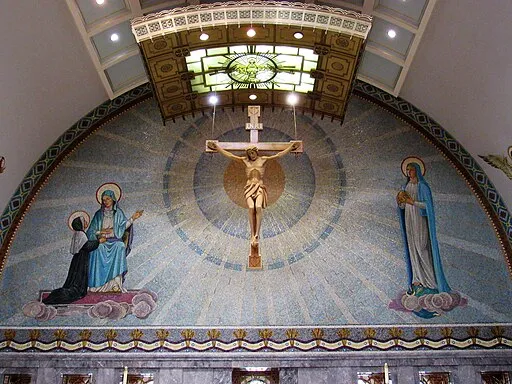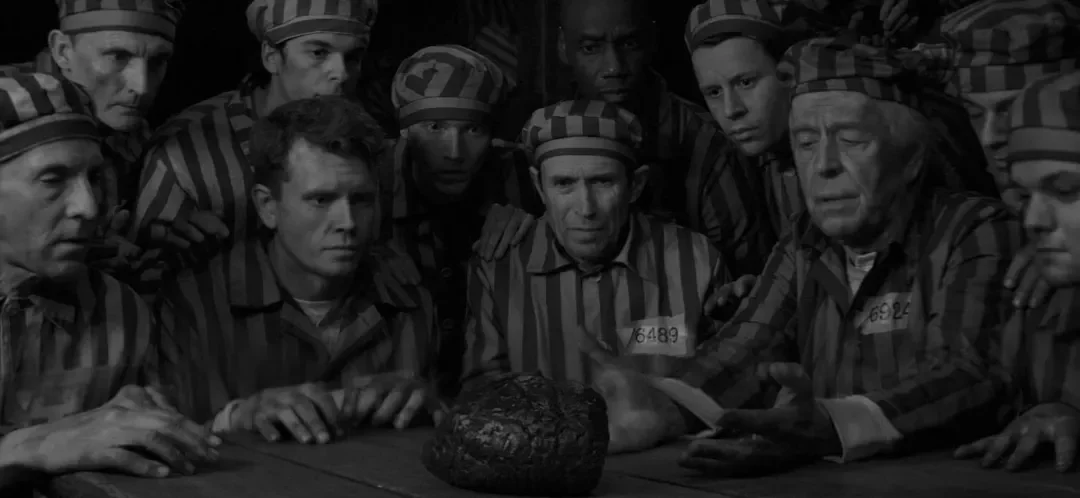St. Frances of Rome (1384-1440) is a remarkable and radiant figure among the pantheon of Catholic saints, who has inspired particular love and veneration since her own times until the present age. A mystic, visionary, and industrious helper of the poor and afflicted, she combined the vocations of a faithful and competent Catholic wife and mother with that of a devout woman of consecrated life.
She was born into a wealthy and illustrious Italian family, and, although she felt called from an early age to offer herself to God as a nun, her family determined instead that she should be married. She accepted this decision in spirit of holy obedience and as the will of God manifested through the circumstances of her life, serving as a good and dedicated wife to her husband (who was also a man of outstanding wealth and nobility) and as a wise and gentle mother to her children. Nevertheless, she continued to follow a demanding regime of prayer, devotion, and Evangelical simplicity consistent with that of consecrated religious life.
Her charitable activities including working in several of the hospitals of Rome, where she would gently tend to the most wretched cases with her own hands. She offered hospitality and charity also to the multitude beggars who then inhabited the city, and her door was always open always both to the destitute and the spiritually afflicted.
A group of other devout women spang up around St. Frances, inspired by her example and joining her in prayer and in the pursuance of works of mercy. Eventually, she established a convent of remarkable beauty and splendor for these holy women, known as the Tor de’ Specchi [“Tower of Mirrors”], which continues as a convent in Rome to this day. One of the unique features of this convent was that it was community of Benedictine oblates—that is, persons who do not take solemn religious vows, but commit themselves to living according to the Rule of St. Benedict in a manner consistent with their own state of life. Today, there are many thousands of Benedictine oblates throughout the world, and St. Frances of Rome is regarded as their foundress and special patron.
Visions And Revelations Given To St. Frances Of Rome
Through much of her life, St. Frances experienced remarkable visions and revelations. Many of these visions occurred after her reception of the holy Eucharist. In the 15th century, most Catholics received the Eucharist only once annually, but Frances received it much more frequently, as the recorded visions collected here attest. Her reception of the Blessed Sacrament (which generally took place in the Chapel of the Angels of the Basilica of Santa Maria in Trastevere, Rome) was always preceded by confession, penance, fasting and prayer, and followed by devout meditation and thanksgiving.
It was in this time of meditation and prayer that these Eucharistic visions typically came to St. Frances. They offer rich and beautiful insights into the power and significance of the great Sacrament of the Body and Blood of the Lord, and illustrate in an unforgettable manner how it serves as a foretaste of the glories of Heaven. The visions are rich in symbolism, and many are filled with profound theological and mystical illuminations.
These mystical works have now been published in English for the first time by the Sophia Institute Press. As a translator, the experience of rendering these wondrous visions into English was itself an act of devotion and prayer, and a source of endless delights and spiritual joy.
For the benefit of Catholic-Link readers, one of St. Frances’s beautiful Eucharistic visions is reproduced in complete form below.
St. France of Rome’s Eucharistic Visions
Vision V
August, 1431
On another occasion, when St. Frances, the handmaid of Christ, had received the most holy Body of Christ, she was praying devoutly (as was her custom) in the Chapel of the Angels, in the Basilica of Santa Maria in Trastevere. Once again, the spirit of the saint was absorbed into a mystical rapture, while her body remained immobile in a trance-like state for a considerable period of time.
When later questioned under holy obedience by her spiritual director, Canon Matteotti, St. Frances related that, in her spirit, she had been transported to a vast plain or field which was wonderfully illuminated with brilliant light. This field was of incredible beauty, its grass glowing with the rich verdure of a precious emerald. And in that field was a wondrous Lamb, whose fleece shone with a radiance exceeding that of the purest snow. Standing close by this Lamb (which was very manifestly none other than the divine Lamb of God), was a noble youth of great delicacy and beaty. He wore upon his shoulders a garment resembling a dalmatic, and a crown woven from flowers and laurels rested upon his head. Surrounding the divine Lamb was also a chorus of other figures in human form, wearing beautiful vestments of a variety of colors and crowned with roses. These human figures (whom Frances recognized to be the souls of the saints) were paying devout homage to the Lamb, and exulting jubilantly in its presence.
The aforementioned youth, wearing the dalmatic, appeared to be leading all the others. As they passed before the Lamb, with great jubilation and devotion they sang thus:
Let us all the Lamb adore
With joyful hearts, for evermore;
Let us to His glory sing,
For He alone is King of kings!
His love He promised to impart
To each and every humble heart:
This love is our supreme reward,
And this pure Lamb, our only Lord!
St. Frances perceived also that there were several streams or rivulets which flowed through this field of astonishing beauty. Each of these streams—which were five in number—flowed with waters of a different color. The noble youth who was vested in a dalmatic led Frances, together with the chorus of the saints, to each of these rivulets in turn, and explained the symbolic meaning of each.
The first of the streams flowed with waters of rich red, which glowed with the roseate luster of a precious ruby. And the angelic youth here exclaimed: “Behold, this first ruby-hued rivulet represents the ardent and invincible love with which Christ redeemed the human race. For it was in the crimson stream of blood that flowed from His wounded side that salvation poured forth for the world!”
The next stream was filled with a liquid of a milky white color, which shone like polished ivory or newly fallen snow. And the youth here said: “This second stream, of immaculate purity and untainted clarity, represents holy innocence. For it is innocence and purity of conscience alone which may ascend the holy mountain of God, to behold there the supreme goodness of the Creator!”
The third stream flowed with waters of shimmering, verdant green. “These are the waters of hope,” exclaimed the youth, “for hope is the virtue which imparts vitality and fertility to all the good and perfect things for which love strives!”
The fourth stream was filled with waters of bright azure blue, resembling the color of the vault of heaven on a cloudless, sunlit day. The youth vested in the dalmatic said: “This stream represents the virtue of holy obedience, which leads the soul on the gentle ways of righteousness, and brings it finally to blessed and blissful union with the divine will.”
The fifth stream was crystal clear and perfectly transparent without any hint of coloring at all, like a precious diamond without fault or flaw. “These transparent and clear waters are the stream of purified faith, unpolluted by any taint or cloud of doubt and fear, and as strong and inviolable as a faultless diamond. The soul that drinks of these waters of perfect faith and which immerses itself in their crystalline purity shall never be separated from the highest beatitude of divine glory!”
At this point, as Frances related, her vision came to an abrupt end, and she found herself once more in her mortal body, in the chapel in which she had been praying. She was then filled with bitter anxiety, and desolation and sorrow that her most glorious vision had been terminated so suddenly. “Alas,” cried the saint sadly, “I have been cruelly deceived! For in my heart, I firmly believed that I would remain in that place of splendor and beauty forever, but now I have returned to this earthly valley of tears and the drab dreariness of mortal life. Yet I know that God never deceives anyone….”
As this point, a certain evil spirit suddenly become visible to Frances. She then realized that it had been this malign entity which had implanted in her mind these dangerous feelings of anxiety and bitterness. So, calling upon the grace and mercy of God, she was able to dispel this wicked demon, together with the dark emotions he had generated. And, having done so, she gave thanks and praise to her loving Lord for revealing to her in this vision a most wonderful foretaste of the beauty and splendor of the celestial kingdom which awaited her in the future.
Frances experienced this vision in the month of August, in the Year of Our Lord 1431.
As a priest and translator, I feel that these writings of this great saint can hardly fail to inspire the fire of divine love—especially for Christ Jesus, truly present in the Sacrament—in the hearts of all those who read them. For this reason, I suggest that they are particularly apt for reading and meditation in preparation for receiving or adoring the most holy Sacrament of the altar, and Our Lord and Savior who is truly and fully present therein; and who lives and reigns forever and ever. Amen.
Read More From St. France Of Rome’s Eucharistic Visions
St. Frances of Rome (1384–1440) displayed mystical gifts from childhood. Though she longed to remain a virgin, her parents arranged a marriage for her, and, as a wife and mother, she led a devout life that mirrored that of a consecrated religious, through fervent prayer and tireless works of charity. In fact, she founded a community of Benedictine oblates who live according to the Rule of St. Benedict, each according to her own state in life; the community now counts thousands of members worldwide.
Frequently, St. Frances experienced ecstasies and visions, especially after receiving Holy Communion. In these absorbing pages, translated by Fr. Robert Nixon, O.S.B., her spiritual director records her life, mystical graces, and miracles as well as her severe demonic attacks and her unwavering trust in God throughout.
These pages are ideal for reflection before or after Mass or during Adoration of the Blessed Sacrament. In the visions of St. Frances, you will encounter the Fountain of light eternal and His embrace as the fire of divine love inflames your heart with more ardent devotion. You will also encounter:
- Brilliant sights, harmonious sounds, and sweet scents of Heaven to fortify your faith
- Five streams of virtue flowing from the Lamb of God to quench your soul’s thirst
- The sure remedy for all distractions and anxieties that impede your love for God
- Sacred Scripture in a fresh, vibrant way to be nourished and renewed
- Lessons from the saints who visited St. Frances on her journey toward Heaven
- Guidance from our Eucharistic King on how to cast aside your worldly cares and ambitions
As you perceive ways to make the sentiments of this great mystic your own and be enriched by her insights, you will draw increased strength from the Holy Eucharist and adore God’s Presence with awe and love as never before. Purchase the book HERE.












